A. Gifford (Westport) Board Rule
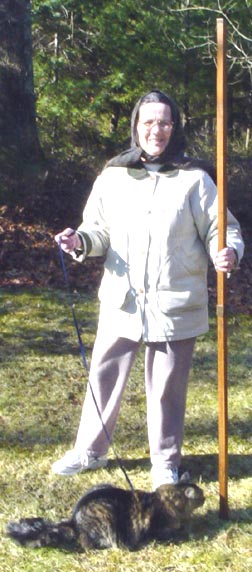 Anthony
Gifford was a whaling captain in the 1830s & 40s whose home and home port was in
our town of Westport, Massachusetts. In the late 1840s or early 1850s, for
reasons that aren't completely clear, he established a rule making factory near
a village, which in this spread-out town, is known as "Head of Westport."
The name derives from the fact that the village is located at the head of the
tide in the local estuary. This is about 10 or 12 miles upstream from the
open Atlantic Ocean. Gifford's rule factory and its rules were the object
of a recent article by Don and Anne Wing, published in The Chronicle of the EAIA.
Anthony
Gifford was a whaling captain in the 1830s & 40s whose home and home port was in
our town of Westport, Massachusetts. In the late 1840s or early 1850s, for
reasons that aren't completely clear, he established a rule making factory near
a village, which in this spread-out town, is known as "Head of Westport."
The name derives from the fact that the village is located at the head of the
tide in the local estuary. This is about 10 or 12 miles upstream from the
open Atlantic Ocean. Gifford's rule factory and its rules were the object
of a recent article by Don and Anne Wing, published in The Chronicle of the EAIA.
Gifford rules were made over a time span that probably was no
longer than about 20 years, and they are fairly uncommon to find today.
The Wings estimate that there may be no more than 75 to 100 in existence.
All of those found to date have been boxwood, brass-jointed, folding rules,
signed with at least two distinctive marks. On the old tool market they
often sell for several hundreds of dollars. Needless to say, as a resident
of the town where they were made, I always keep my eyes open for fresh examples.
Recently that alertness was rewarded with finding an A. Gifford
rule that, unlike all other known examples, is a beech log rule or "stick", 72
inches long, and stamped on all four sides with a table of values that probably
represent the board footage of logs with defined lengths and girths.
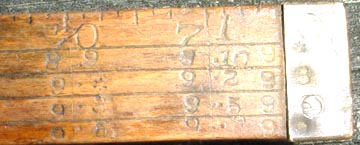 The
six foot rule is square, about 1 inch on a side, and has ends capped with brass
plates that are bent over on two sides and riveted to the wood. The ends
hold a brass slide captive, and this side acts as a cursor (with a bent tongue
that serves as a spring stop).
The
six foot rule is square, about 1 inch on a side, and has ends capped with brass
plates that are bent over on two sides and riveted to the wood. The ends
hold a brass slide captive, and this side acts as a cursor (with a bent tongue
that serves as a spring stop).
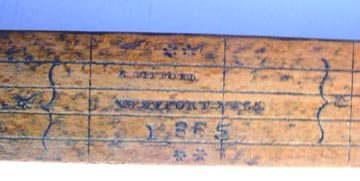 The rule
is marked,
The rule
is marked,
" A. Gifford
Westport, Mass.
1865"
and is decorated with many starbursts and the curved brackets
typical of Gifford boxwood rules.
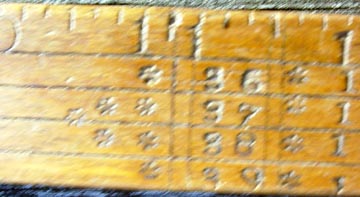 The four
sides of the rule are each divided by longitudinal lines into five equal
columns, and these are crossed by vertical lines at one inch intervals.
Along one edge the rule is graduated into 72" with 1/8" gradations. Below
this, and continuing around the rule on the four sides are lengthwise columns
labeled, "36, 37, 38, 39, 40, 41, 42, 43, 44, 45, 46, 47, 48, 49, 50.
These represent inches of what is probably the girth of logs.
The four
sides of the rule are each divided by longitudinal lines into five equal
columns, and these are crossed by vertical lines at one inch intervals.
Along one edge the rule is graduated into 72" with 1/8" gradations. Below
this, and continuing around the rule on the four sides are lengthwise columns
labeled, "36, 37, 38, 39, 40, 41, 42, 43, 44, 45, 46, 47, 48, 49, 50.
These represent inches of what is probably the girth of logs.
The brass slide or cursor is similarly marked, with the heading
"inches" very obviously stamped at the top of the columns. The cursor is
also stamped with numerous starbursts and the characteristic curved brackets.

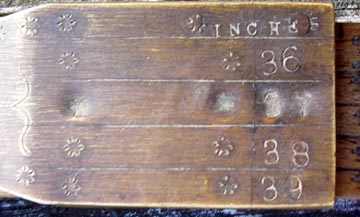
When looking at other examples of Gifford's products in the Don
& Ann Wing Collection, it is apparent that the Gifford factory used at least two
sets of number and letter stamps, with one being larger than the other.
The "A. Gifford" on this rule is identical with the smaller set, thought to be
found on the earlier rules in Gifford's production. However, some of the
numbers found on the graduated edge of the rule are consistent with the larger
set of stamps also used by Gifford. Actually, there are at least three and
perhaps four sizes of stamps on this rule. In the following picture, for
example, the "48" and "49" on the graduated edge show two sizes of "4" stamps,
and a "9" that is clearly larger than the adjacent "8". The resultants in
the columns below are from a still smaller stamp set.
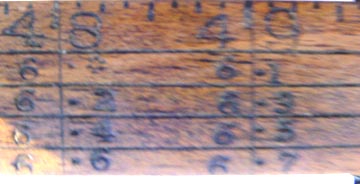
This rule raises some interesting questions about the Gifford company and its
products. First, the rule is in excellent condition for a rule that would
normally have been handled very roughly under adverse conditions that accompany
log rules. Is it possible that this is a one of a kind rule, made for use
in the Gifford factory? It was found, by the way, in a local Westport
home. Second, the date--1865--represents a very late period in the history
of the Gifford factory. Anthony Gifford died in 1862, and the driving
force in his company, Mortimer Hedge, was in the Civil War in 1865. One of
Gifford's sons had passed away by this time, and the company is thought to have
lost its viability by 1867 at the latest.
This is a rule that will be treasured by its new owners in
Westport, Mass.
 Anthony
Gifford was a whaling captain in the 1830s & 40s whose home and home port was in
our town of Westport, Massachusetts. In the late 1840s or early 1850s, for
reasons that aren't completely clear, he established a rule making factory near
a village, which in this spread-out town, is known as "Head of Westport."
The name derives from the fact that the village is located at the head of the
tide in the local estuary. This is about 10 or 12 miles upstream from the
open Atlantic Ocean. Gifford's rule factory and its rules were the object
of a recent article by Don and Anne Wing, published in The Chronicle of the EAIA.
Anthony
Gifford was a whaling captain in the 1830s & 40s whose home and home port was in
our town of Westport, Massachusetts. In the late 1840s or early 1850s, for
reasons that aren't completely clear, he established a rule making factory near
a village, which in this spread-out town, is known as "Head of Westport."
The name derives from the fact that the village is located at the head of the
tide in the local estuary. This is about 10 or 12 miles upstream from the
open Atlantic Ocean. Gifford's rule factory and its rules were the object
of a recent article by Don and Anne Wing, published in The Chronicle of the EAIA. The
six foot rule is square, about 1 inch on a side, and has ends capped with brass
plates that are bent over on two sides and riveted to the wood. The ends
hold a brass slide captive, and this side acts as a cursor (with a bent tongue
that serves as a spring stop).
The
six foot rule is square, about 1 inch on a side, and has ends capped with brass
plates that are bent over on two sides and riveted to the wood. The ends
hold a brass slide captive, and this side acts as a cursor (with a bent tongue
that serves as a spring stop). The rule
is marked,
The rule
is marked,  The four
sides of the rule are each divided by longitudinal lines into five equal
columns, and these are crossed by vertical lines at one inch intervals.
Along one edge the rule is graduated into 72" with 1/8" gradations. Below
this, and continuing around the rule on the four sides are lengthwise columns
labeled, "36, 37, 38, 39, 40, 41, 42, 43, 44, 45, 46, 47, 48, 49, 50.
These represent inches of what is probably the girth of logs.
The four
sides of the rule are each divided by longitudinal lines into five equal
columns, and these are crossed by vertical lines at one inch intervals.
Along one edge the rule is graduated into 72" with 1/8" gradations. Below
this, and continuing around the rule on the four sides are lengthwise columns
labeled, "36, 37, 38, 39, 40, 41, 42, 43, 44, 45, 46, 47, 48, 49, 50.
These represent inches of what is probably the girth of logs.

